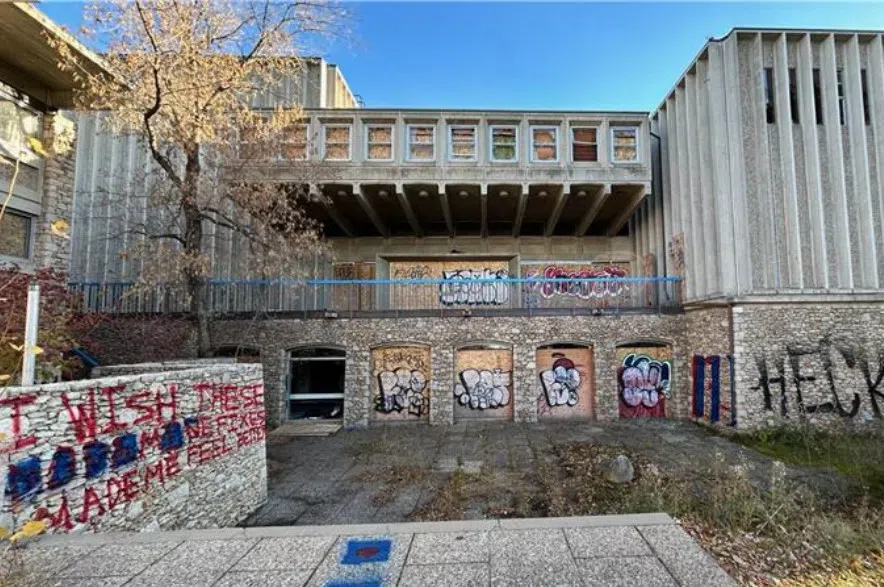The University of Saskatchewan’s decision to demolish the two historic buildings at 113 and 114 Seminary Crescent has ignited a storm of criticism from preservation advocates and community leaders, who argue the process was flawed and prematurely shut down proposals for meaningful redevelopment.
The site has been vacant since 2020 and issues have arisen with vandalism and trespassing ever since the seminary moved to a location in St. Andrew’s College building four years ago. The university’s security team responded to more than 160 security calls there in 2024, and there have been two internal fires, broken windows and other issues since the site has been unoccupied.
Read More:
- Former U of S Lutheran Theological Seminary to be demolished
- U of S wants to demolish vacant former Lutheran seminary building
- Nutrien makes ‘transformational’ $15M donation to University of Saskatchewan
In a news release issued last month, the university cited financial concerns, public safety and alignment with its long-term strategic plan as the reasons behind the decision to demolish the former seminary.
But members of the grassroots group Friends of 114 Seminary Crescent say key facts have been misrepresented and important opportunities disregarded along the way.
“There was going to be a phase two; that was our understanding,” said Monica Kreuger, a founding member of the group.
“Then we were informed by the board that there was not a successful (expression of interest), and that was a big shock. The proponents felt that there would have been a phase two.”
Kreuger said two of the proposals her group supported – one from the Saskatoon Tribal Council and another from the Saskatchewan Child Advocacy Centre – offered both social value and alignment with the university’s mission.
“They’re both wonderful ways to be contributing to truth and reconciliation and also be providing great supports to our brothers and sisters in this province,” Kreuger said.
She also challenged the university’s description of the buildings as structurally unsound and hazardous.
“When we were able to get a walk through the building, they said ‘This building is absolutely solid.’ There’s nothing about it falling down.”
The University of Saskatchewan maintains that the decision followed a thorough review.
“We had entered into a pause on the demolition for an expression of interest and had received, I believe, five expressions,” said Wade Epp, the university’s associate vice president of services.
He said the expressions of interest were “not financially viable,” so the university decided to “proceed with the difficult decision to demolish.”
Citing a recent third-party safety and feasibility review, Epp said the university needed to act swiftly.
“It’s financial viability and ultimately safety for our campus and those that use it,” he said.
The Friends of 114 disputed that characterization.
“Communication with the Saskatoon Fire Department confirmed there were no demolition orders for either building. The Fire Department does not require buildings to be made operational,” the organization wrote in a media release on Tuesday.
The group also took issue with the shifting cost estimates.
“Respondents were assured the EOI process would be phased,” the group added. “No second phase occurred, and the much higher $55–$60 million estimate was never disclosed to proponents during the process.”
The university plans to turn the sites into green space, expanding access to the Meewasin pathways.
“The long-term vision was to return it to its natural space,” Epp said.
“It fits well with its location and alignment with connection… with the potential for an urban national park and for broader use through the community.”
But critics of the move argued that heritage, sustainability, and reconciliation were sidelined during the process.
“It makes you wonder, like are we serious about the things we say we’re serious about?” said Kreuger.
She added that the Friends of 114 are still seeking dialogue with the university.
“All we want is conversation,” she said. “We’re still working forward. We still have more people coming to the table with more ideas.”
A timeline for demolition has not been released, though Epp confirmed that asbestos abatement will begin in the coming months.
“There’s a large amount of asbestos and other contaminants in that space that would have to be addressed before it’s knocked down safely,” he noted.
But Kreuger said she didn’t hear about any structural issues when she toured the site.
“When we were able to get a walk through of the building, they said ‘this building is absolutely solid.’ There’s nothing about it falling down… there’s no way that it’s ready to be bulldozed, that’s for sure.”
As tensions rise, the debate over the fate of the Seminary Crescent buildings continues to resonate beyond the university, raising broader questions about heritage, safety, and the university’s role in community engagement and reconciliation.











